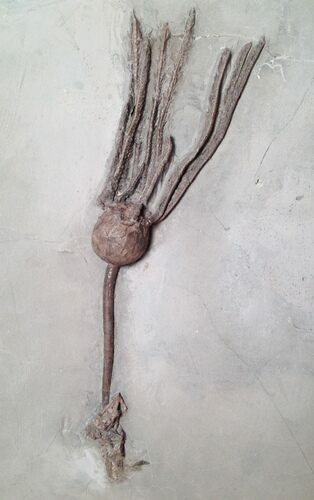This Specimen has been sold.
5.5" Caryocrinites Cystoid From NY - Very 3D
This is a hard to acquire Caryocrinites ornatus cystoid from the Rochester Shale of New York. These cystoids come out of a layer in Caleb's quarry that's been exhausted for over 10 years. This specimen were collected by the late Bill White in the 90's. These were very unique finds because cystoids are almost always (99% of the time) found without arms or stems.
This cystoid specimen is very inflated, 5 1/2" long including the stem and hold fast and is centered on a 7x5" slab of shale matrix. Really a beautiful piece.
This cystoid specimen is very inflated, 5 1/2" long including the stem and hold fast and is centered on a 7x5" slab of shale matrix. Really a beautiful piece.
Cystoids are extinct echinoderms similar to crinoids. They consist of a stalk, theca (body), and brachials (feeding arms). Most lived fixed to the seafloor, but some were more mobile. Like modern echinoderms, cystoids were arranged in a fivefold symmetric pattern and had a water vascular system. However, unlike most echinoderms, cystoids had triangular calcite plates at their body openings containing pores that are thought to have been for breathing.
Cystoids first appear in the Cambrian Period and reached peak diversity during the Ordivician and Silurian Periods. Cystoids died out at the end of the Devonian or early in the Carboniferous Period.
Cystoids resembled flowers, but were in fact animals. They had a stem that attached them to the seafloor, a theca, and brachials. The theca contained the cystoid's vital organs and was made up of calcite plates that formed a spherical or ovate body. The brachials were the feeding arms that extended from the top of the theca, arranged in three- or five-fold symmetry, and funneled food to the mouth at their center. Cystoids and crinoids look similar but have some distinct differences. The main difference is in the shape of the main body of the organisms: cystoids had a spherical or ovate theca, while crinoids had a cup shaped calyx. Cystoids also had triangular plates at body openings while crinoids had variably shaped plates.
Cystoids first appear in the Cambrian Period and reached peak diversity during the Ordivician and Silurian Periods. Cystoids died out at the end of the Devonian or early in the Carboniferous Period.
Cystoids resembled flowers, but were in fact animals. They had a stem that attached them to the seafloor, a theca, and brachials. The theca contained the cystoid's vital organs and was made up of calcite plates that formed a spherical or ovate body. The brachials were the feeding arms that extended from the top of the theca, arranged in three- or five-fold symmetry, and funneled food to the mouth at their center. Cystoids and crinoids look similar but have some distinct differences. The main difference is in the shape of the main body of the organisms: cystoids had a spherical or ovate theca, while crinoids had a cup shaped calyx. Cystoids also had triangular plates at body openings while crinoids had variably shaped plates.
SPECIES
Caryocrinites ornatus
AGE
LOCATION
Caleb's Quarry, Middleport, New York
FORMATION
Rochester Shale
SIZE
5.5" on 7x5" Matrix
CATEGORY
SUB CATEGORY
ITEM
#9254
We guarantee the authenticity of all of our specimens.
 Reviews
Reviews















